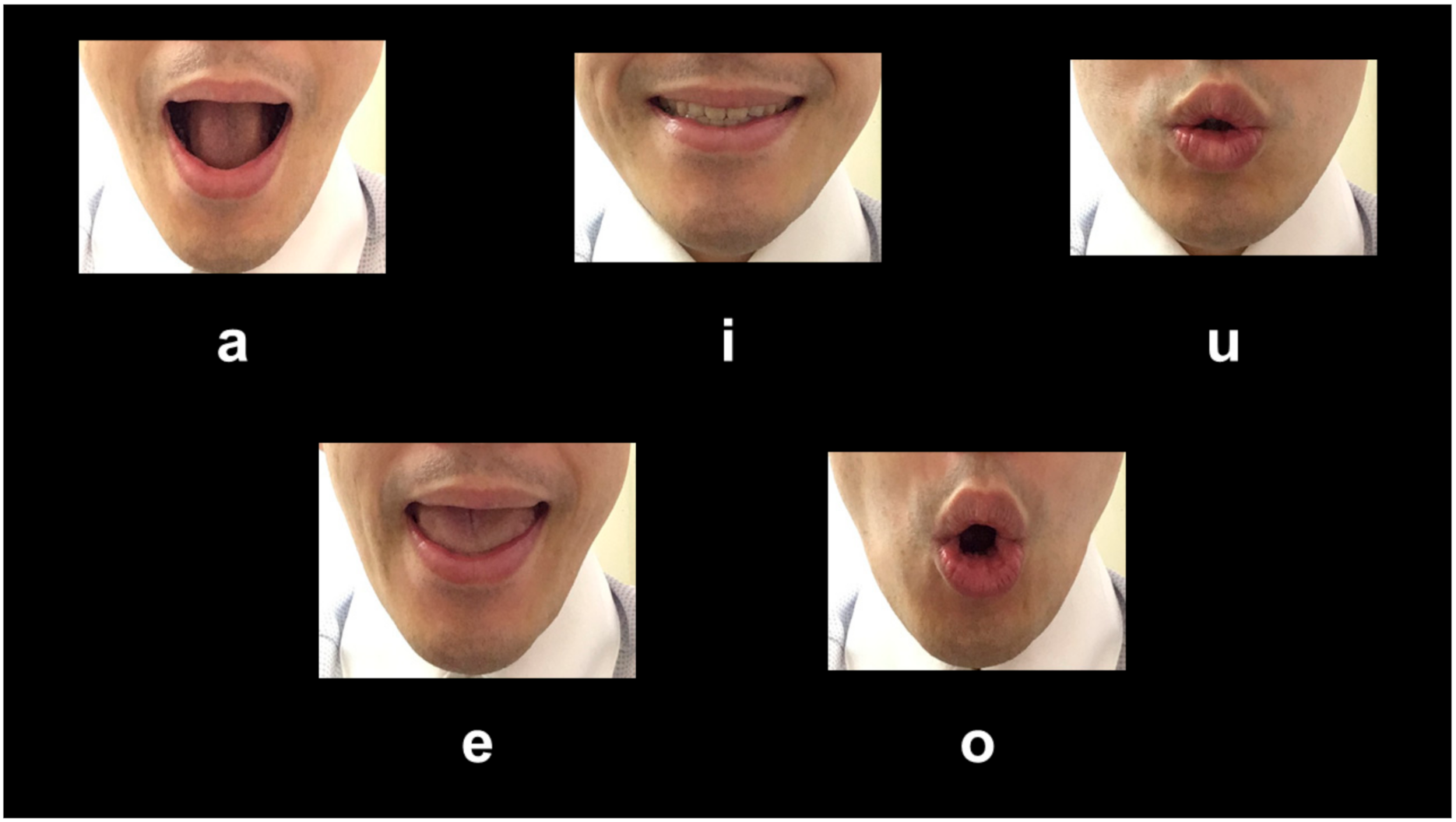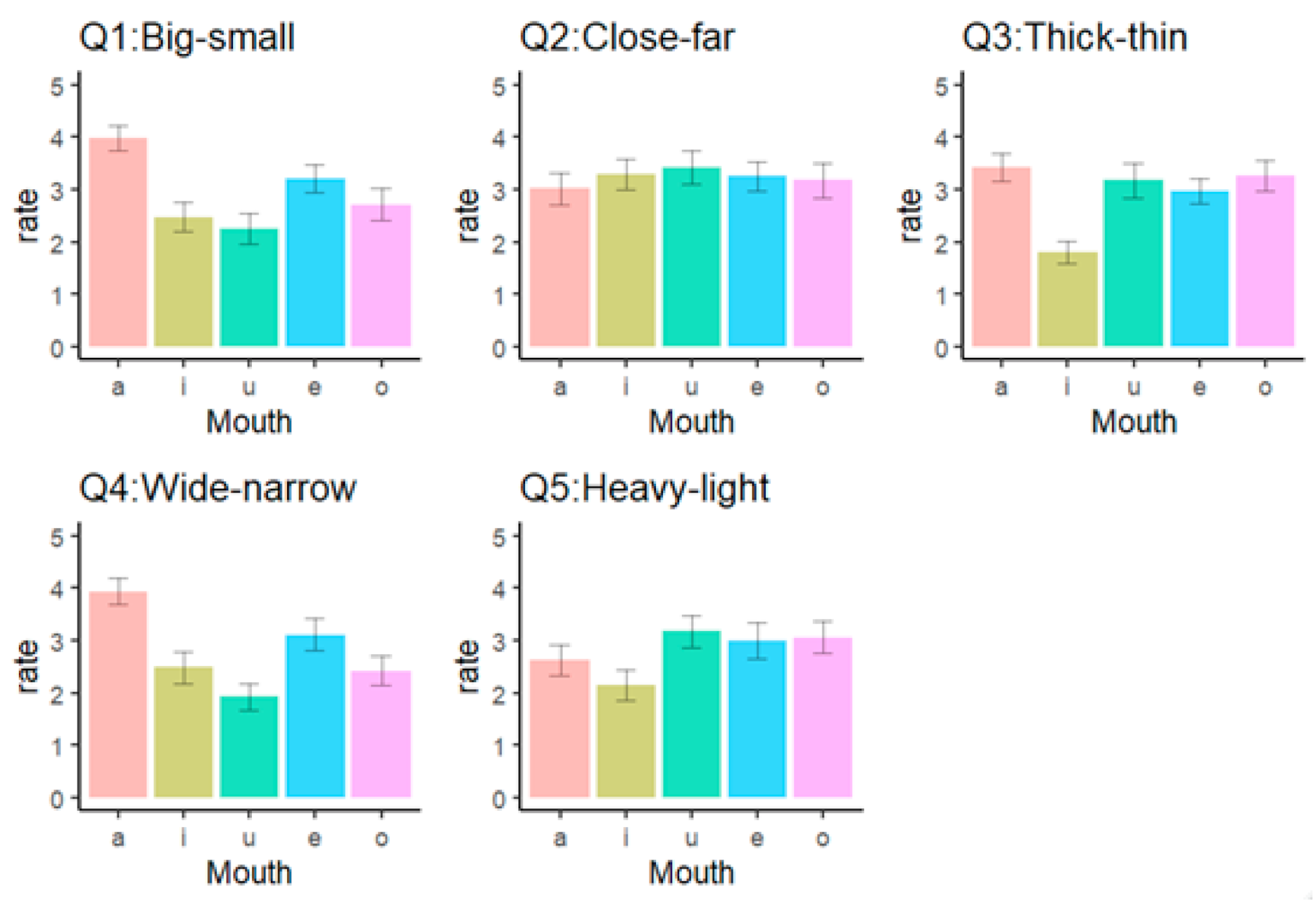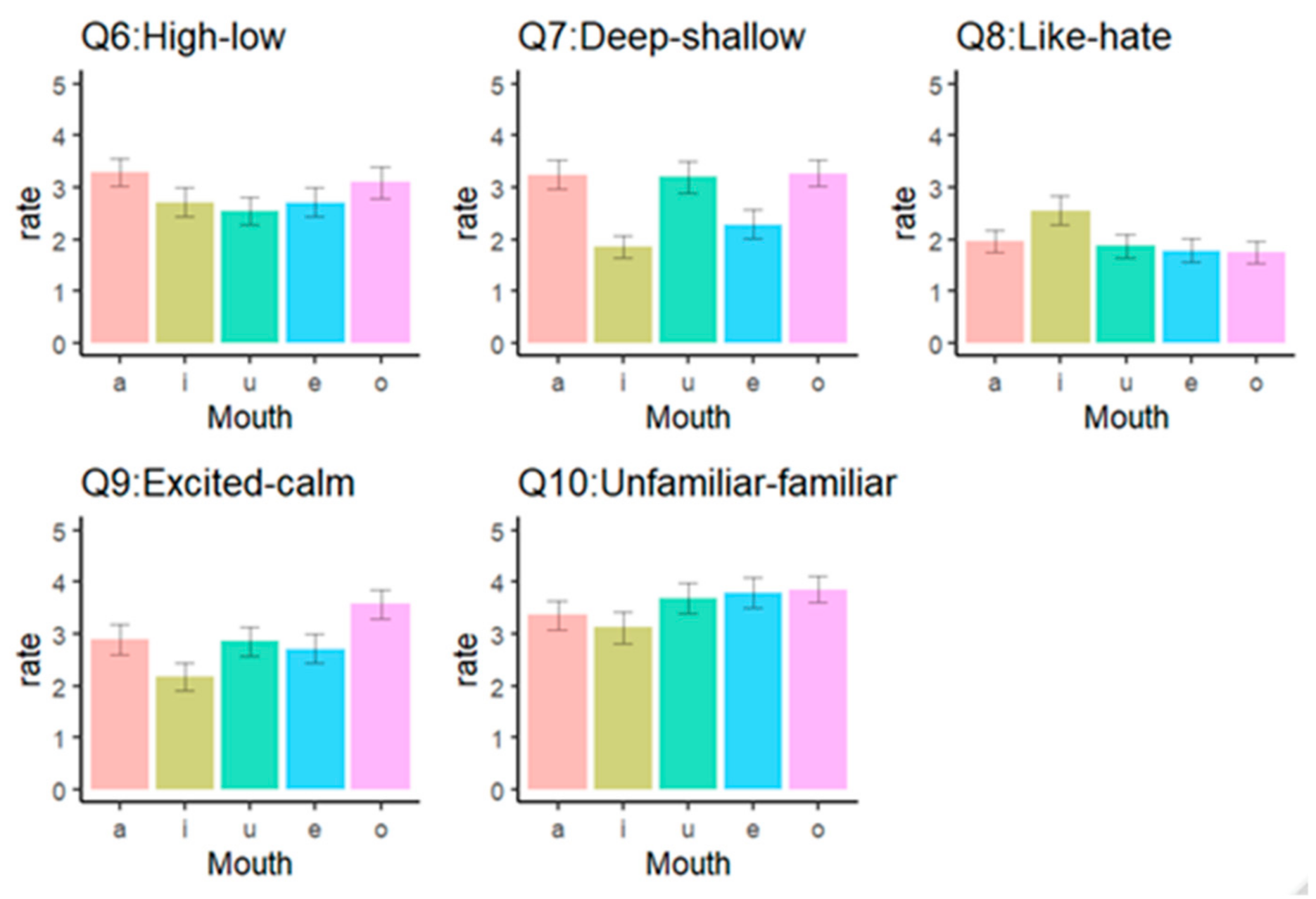Semantics Based on the Physical Characteristics of Facial Expressions Used to Produce Japanese Vowels
Abstract
:1. Introduction
2. Materials and Methods
2.1. Participants
2.2. Materials
2.3. Procedure
2.4. Statistical Analysis
3. Results
3.1. Big-Small (Q1: Size)
3.2. Close-Far (Q2: Distance)
3.3. Thick-Thin (Q3: Thickness)
3.4. Wide-Narrow (Q4: Extent)
3.5. Heavy-Light (Q5: Weight)
3.6. High-Low (Q6: Height)
3.7. Deep-Shallow (Q7: Depth)
3.8. Like-Hate (Q8: Preference)
3.9. Excited-Calm (Q9: Arousal)
3.10. Unfamiliar-Familiar (Q10: Familiarity: A Reverse Item)
4. Discussion
Limitations
5. Conclusions
Author Contributions
Funding
Acknowledgments
Conflicts of Interest
Data Availability Statement
References
- Köhler, W. Gestalt Psychology; Liveright: New York, NY, USA, 1929. [Google Scholar]
- Maurer, D.; Pathman, T.; Mondloch, C.J. The shape of boubas: Sound-shape correspondences in toddlers and adults. Dev. Sci. 2006, 9, 316–322. [Google Scholar] [CrossRef] [PubMed]
- Ramachandran, V.S.; Hubbard, E.M. Synaesthesia: A window into perception, thought, and language. J. Conscious. Stud. 2001, 8, 3–34. [Google Scholar]
- Newman, S.S. Further experiments on phonetic symbolism. Am. J. Psychol. 1933, 45, 53–75. [Google Scholar] [CrossRef] [Green Version]
- Sapir, E. A study in phonetic symbolism. J. Exp. Psychol. 1929, 12, 225–239. [Google Scholar] [CrossRef] [Green Version]
- Ohala, J.J. An ethological perspective on common cross-language utilization of F₀ of voice. Phonetica 1984, 41, 1–16. [Google Scholar] [CrossRef] [Green Version]
- Gesn, P.R.; Ickes, W. The development of meaning contexts for empathic accuracy: Channel and sequence effects. J. Pers. Soc. Psychol. 1999, 77, 746–761. [Google Scholar] [CrossRef]
- Gaebel, W.; Wölwer, W. Facial expressivity in the course of schizophrenia and depression. Eur. Arch. Psychiatry Clin. Neurosci. 2004, 254, 335–342. [Google Scholar] [CrossRef]
- Kocsor, F.; Kozma, L.; Neria, A.L.; Jones, D.N.; Bereczkei, T. Arbitrary signals of trustworthiness—Social judgments may rely on facial expressions even with experimentally manipulated valence. Heliyon 2019, 5, e01736. [Google Scholar] [CrossRef] [Green Version]
- Krumhuber, E.; Manstead, A.S.R.; Cosker, D.; Marshall, D.; Rosin, P.L. Effects of dynamic attributes of smiles in human and synthetic faces: A simulated job interview setting. J. Nonverbal Behav. 2009, 33, 1–15. [Google Scholar] [CrossRef] [Green Version]
- Suzuki, K.; Naitoh, K. Brief report: Useful information for face perception is described with FACS. J. Nonverbal Behav. 2003, 27, 43–55. [Google Scholar] [CrossRef]
- Wang, Y.; Zhu, Z.; Chen, B.; Fang, F. Perceptual learning and recognition confusion reveal the underlying relationships among the six basic emotions. Cog. Emot. 2019, 33, 754–767. [Google Scholar] [CrossRef] [PubMed]
- Ekman, P. An argument for basic emotions. Cogn. Emot. 1992, 6, 169–200. [Google Scholar] [CrossRef]
- Tomkins, S.S.; McCarter, R. What and where are the primary affects? Some evidence for a theory. Percept. Mot. Skills. 1964, 18, 119–158. [Google Scholar] [CrossRef] [PubMed]
- Crivelli, C.; Fridlund, A.J. Inside-out: From basic emotions theory to the behavioral ecology view. J. Nonverbal Behav. 2019, 43, 161–194. [Google Scholar] [CrossRef]
- Fridlund, A.J. The Behavioral Ecology View of Facial Displays, 25 Years Later. 2015. Available online: http://emotionresearcher.com/the-behavioral-ecology-view-of-facial-displays-25-years-later/ (accessed on 11 March 2020).
- Scarantino, A. How to do things with emotional expressions: The theory of affective pragmatics. Psychol. Inq. 2017, 28, 165–185. [Google Scholar] [CrossRef]
- Barrett, L.F.; Adolphs, R.; Marsella, S.; Martinez, A.M.; Pollak, S.D. Emotional expressions reconsidered: Challenges to inferring emotion from human facial movements. Psychol. Sci. Public Interest 2019, 20, 1–68. [Google Scholar] [CrossRef] [Green Version]
- Durán, J.I.; Reisenzein, R.; Fernández-Dols, J.M. Coherence between emotions and facial expressions: A research synthesis . In The Science of Facial Expression; Fernández-Dols, J.M., Russell, J.A., Eds.; Oxford University Press: New York, NY, USA, 2017; pp. 107–129. [Google Scholar]
- Hyniewska, S.; Sato, W.; Kaiser, S.; Pelachaud, C. Naturalistic emotion decoding from facial action sets. Front. Psychol. 2018, 9, 2678. [Google Scholar] [CrossRef]
- Reschke, P.J.; Walle, E.A.; Knothe, J.M.; Lopez, L.D. The influence of context on distinct facial expressions of disgust. Emotion 2019, 19, 365–370. [Google Scholar] [CrossRef]
- Namba, S.; Kabir, R.S.; Miyatani, M.; Nakao, T. Spontaneous facial actions map onto emotional experiences in a non-social context: Toward a component-based approach. Front. Psychol. 2017, 8, 633. [Google Scholar] [CrossRef] [Green Version]
- Hamano, S. The Sound-Symbolic System of Japanese (Studies in Japanese Linguistics); CSLI Publicatins & Kurosio: Stanford, CA, USA; Tokyo, Japan, 1998. [Google Scholar]
- Rummer, R.; Schweppe, J.; Schlegelmilch, R.; Grice, M. Mood is linked to vowel type: The role of articulatory movements. Emotion 2014, 14, 246–250. [Google Scholar] [CrossRef]
- McIntosh, D.N.; Zajonc, R.B.; Vig, P.S.; Emerick, S.W. Facial movement, breathing, temperature, and affect: Implications of the vascular theory of emotional efference. Cog. Emot. 1997, 11, 171–196. [Google Scholar] [CrossRef]
- Zajonc, R.B.; Murphy, S.T.; Inglehart, M. Feeling and facial efference: Implications of the vascular theory of emotions. Psychol. Rev. 1989, 96, 395–416. [Google Scholar] [CrossRef] [PubMed]
- Ono, M. (Ed.) Nihongo Onomatope Jiten (Japanese Onomatopoeia Dictionary); Shogakukan: Tokyo, Japan, 2007. [Google Scholar]
- Asano, M.; Imai, M.; Kita, S.; Kitajo, K.; Okada, H.; Thierry, G. Sound symbolism scaffolds language development in preverbal infants. Cortex 2015, 63, 196–205. [Google Scholar] [CrossRef] [PubMed] [Green Version]
- Hoshi, H.; Kwon, N.; Akita, K.; Auracher, J. Semantic associations dominate over perceptual associations in vowel–size iconicity. i-Perception 2019, 10, 1–31. [Google Scholar] [CrossRef] [Green Version]
- Imai, M.; Kita, S. The sound symbolism bootstrapping hypothesis for language acquisition and language evolution. Philos. Trans. R. Soc. B 2014, 369, 20130298. [Google Scholar] [CrossRef] [Green Version]
- Imai, M.; Kita, S.; Nagumo, M.; Okada, H. Sound symbolism facilitates early verb learning. Cognition 2008, 109, 54–65. [Google Scholar] [CrossRef]
- Kambara, T.; Umemura, T. The relationships between initial consonants in Japanese sound symbolic words and familiarity, multi-sensory imageability, emotional valence, and arousal. J. Psych. Res. 2020. accepted. [Google Scholar]
- Kantartzis, K.; Imai, M.; Kita, S. Japanese sound-symbolism facilitates word learning in English-speaking children. Cogn. Sci. 2011, 35, 575–586. [Google Scholar] [CrossRef]
- Kawahara, S. Sound symbolism and theoretical phonology. Lang. Linguist. Compass 2020, 14, e12372. [Google Scholar] [CrossRef]
- Motoki, K.; Saito, T.; Park, J.; Velasco, C.; Spence, C.; Sugiura, M. Tasting names: Systematic investigations of taste-speech sounds associations. Food. Qual. Pref. 2020, 80, 103801. [Google Scholar] [CrossRef]
- Osaka, N. Ideomotor response and the neural representation of implied crying in the human brain: An fMRI study using onomatopoeia. Jpn. Psychol. Res. 2011, 53, 372–378. [Google Scholar] [CrossRef] [Green Version]
- Shinohara, K.; Kawahara, S. A cross-linguistic study of sound symbolism. In Proceedings of the Annual Meeting of the Berkeley Linguistics Society; University of California Press: Berkeley, CA, USA, 2010; pp. 396–410. [Google Scholar] [CrossRef]
- Klink, R.R. Creating brand names with meaning: The use of sound symbolism. Mark. Lett. 2000, 11, 5–20. [Google Scholar] [CrossRef]
- Adelman, J.S.; Estes, Z.; Cossu, M. Emotional sound symbolism: Languages rapidly signal valence via phonemes. Cognition 2018, 175, 122–130. [Google Scholar] [CrossRef] [PubMed] [Green Version]
- Aryani, A.; Jacobs, A.M. Affective congruence between sound and meaning of words facilitates semantic decision. Behav. Sci. 2018, 8, 56. [Google Scholar] [CrossRef] [PubMed] [Green Version]
- Aryani, A.; Conrad, M.; Schmidtke, D.; Jacobs, A. Why ‘piss’ is ruder than ‘pee’? The role of sound in affective meaning making. PLoS ONE 2018, 13, e0198430. [Google Scholar] [CrossRef] [Green Version]
- Aryani, A.; Hsu, C.T.; Jacobs, A.M. The sound of words evokes affective brain responses. Brain Sci. 2018, 8, 94. [Google Scholar] [CrossRef] [PubMed] [Green Version]
- Aryani, A.; Hsu, C.T.; Jacobs, A.M. Affective iconic words benefit from additional sound-meaning integration in the left amygdala. Hum. Brain Map. 2019, 40, 5289–5300. [Google Scholar] [CrossRef]
- Aryani, A.; Isbilen, E.S.; Christiansen, M.H. Affective Arousal Links Sound to Meaning. Psych. Sci. 2020, 31, 978–986. [Google Scholar] [CrossRef]
- Hara, F.; Endo, K. Dynamic control of lip-configuration of a mouth robot for Japanese vowels. Robot. Auton. Syst. 2000, 31, 161–169. [Google Scholar] [CrossRef]
- Osgood, C.E.; Suci, G.J.; Tannenbaum, P.H. The Measurement of Meaning; University of Illinois Press: Urbana, IL, USA, 1957. [Google Scholar]
- Sato, K.; Mitsukura, Y. Effects of music on image impression and relationship between impression and physical properties. Electron. Commn. Jpn. 2013, 96, 1451–1458. [Google Scholar] [CrossRef]
- Perovic, S.; Folic, N.K. Visual perception of public open spaces in Niksic. Procedia Soc. Behav. Sci. 2012, 69, 921–933. [Google Scholar] [CrossRef] [Green Version]
- Hamano, S. The Sound-Symbolic System of Japanese. Ph.D. Dissertation, University of Florida, Gainesville, FL, USA, 1986. [Google Scholar]
- Fukuda, Y.; Hiki, S. Characteristics of the mouth shape in the production of Japanese—Stroboscopic observation. J. Acoust. Soc. Jpn. 1982, 3, 75–91. [Google Scholar] [CrossRef] [Green Version]
- Strack, F.; Martin, L.L.; Stepper, S. Inhibiting and facilitating conditions of the human smile: A nonobtrusive test of the facial feedback hypothesis. J. Pers. Soc. Psychol. 1988, 54, 768–777. [Google Scholar] [CrossRef] [PubMed]
- Namba, S.; Makihara, S.; Kabir, R.S.; Miyatani, M.; Nakao, T. Spontaneous facial expressions are different from posed facial expressions: Morphological properties and dynamic sequences. Curr. Psychol. 2017, 36, 593–605. [Google Scholar] [CrossRef]



| Size | Distance | Thickness | Extent | Weight | Height | Depth | Preference | Unfamiliarity | |
|---|---|---|---|---|---|---|---|---|---|
| Distance | −0.11 | ||||||||
| Thickness | 0.30 | 0.03 | |||||||
| Extent | 0.57 | −0.01 | 0.22 | ||||||
| Weight | 0.12 | 0.18 | 0.36 | 0.06 | |||||
| Height | 0.16 | −0.04 | −0.02 | 0.17 | −0.13 | ||||
| Depth | 0.25 | 0.11 | 0.34 | 0.12 | 0.28 | 0.06 | |||
| Preference | 0.00 | −0.03 | −0.18 | 0.07 | −0.16 | 0.04 | −0.09 | ||
| Arousal | 0.10 | 0.08 | 0.24 | 0.01 | 0.19 | 0.02 | 0.23 | −0.18 | |
| Unfamiliarity | −0.03 | 0.04 | 0.13 | −0.12 | 0.23 | −0.07 | 0.08 | −0.43 | 0.23 |
© 2020 by the authors. Licensee MDPI, Basel, Switzerland. This article is an open access article distributed under the terms and conditions of the Creative Commons Attribution (CC BY) license (http://creativecommons.org/licenses/by/4.0/).
Share and Cite
Namba, S.; Kambara, T. Semantics Based on the Physical Characteristics of Facial Expressions Used to Produce Japanese Vowels. Behav. Sci. 2020, 10, 157. https://doi.org/10.3390/bs10100157
Namba S, Kambara T. Semantics Based on the Physical Characteristics of Facial Expressions Used to Produce Japanese Vowels. Behavioral Sciences. 2020; 10(10):157. https://doi.org/10.3390/bs10100157
Chicago/Turabian StyleNamba, Shushi, and Toshimune Kambara. 2020. "Semantics Based on the Physical Characteristics of Facial Expressions Used to Produce Japanese Vowels" Behavioral Sciences 10, no. 10: 157. https://doi.org/10.3390/bs10100157
APA StyleNamba, S., & Kambara, T. (2020). Semantics Based on the Physical Characteristics of Facial Expressions Used to Produce Japanese Vowels. Behavioral Sciences, 10(10), 157. https://doi.org/10.3390/bs10100157






